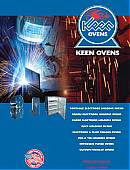Proper
Storage of 7018 Rods to
Prevent Defects - Part 1 I
just answered a question for Practical Welding Today about proper welding
electrode storage. In it I referenced that welding with 7018 rods that have moisture
in them will introduce you to one of the common weld defects…porosity. 7018
welding rods allow very little hydrogen into the weld pool unless they have moisture
in them from not being stored correctly. Moisture allows hydrogen into the flux,
which is then introduced into the weld pool adversely. What happens is the
moisture is superheated and then bubbles up to the surface leaving an open pocket
in the finished weld bead. So at that spot the weld is weaker because it is not
a solid bead.
Click here to view our welding ovens and to learn
about the benefits of proper storage!
Many people just leave 7018 welding electrodes in the boxes
they come in, while others think they are using proper storage methods when they
really are not. There are three common myths that are really widespread in the
shop and field. One is wrapping the welding rods in plastic and storing
them in your freezer. Besides making your wife mad as hell, this will actually
introduce moisture into the flux. As soon as the package is brought out into the
atmosphere, it will be attacked by moisture from the cold rods being soaked in
the warm outside air. I wear glasses, and on a cold winter day my glasses
immediately fog over when I walk into a warm room. That's the same effect you're
gonna' get with your freezer rods. Another, and probably the most widely
spread and widely used myth is putting the welding electrodes in an old refrigerator
with a constantly burning light bulb inside. (Remember that old question: If a
tree falls in a forest and no one is there will it make a sound? Or does the light
bulb REALLY go off when you close the freezer door? Well in this case you WANT
the bulb burning all the time.) Supposedly the bulb will make it hot enough
in the refrigerator to keep the welding rods at the recommended temperature. Only
trouble is there ain't no light bulb out there that is going to keep a constant
250 to 450 degrees, which is the correct specification for open welding electrode
boxes! It's something like using a garden hose to put out a forest fire, just
not gonna' work. Now don't feel bad if you've done this because I've done
it too, and I've seen major shops and building corporations doing it too! I worked
in a huge "black iron" shop where they did millions of dollars of fabrication
and production of beams, girders, columns and the like for the construction industry.
Our storage area consisted of a dusty little room with a crummy refrigerator with
a 150 watt light bulb. I remember seeing the chief engineer come in for
a job we were doing for an "earthquake proof" (yeah, I'll believe that
when I see it!) hospital in California. He had come in to make sure us welders
were properly certified. When he saw that pitiful little welding electrode storage
area he just about shut the whole job down! It took a lot of convincing and the
ordering of a REAL welding rod oven to make him happy again! Continue
to Part 2
| ![]() Under 10 cubic feet
Under 10 cubic feet![]() 10-20 cubic feet
10-20 cubic feet![]() Over 20 cubic feet
Over 20 cubic feet![]() See All
See All![]() Under 10 cubic feet
Under 10 cubic feet![]() 10-20 cubic feet
10-20 cubic feet![]() Over 20 cubic feet
Over 20 cubic feet![]() See All
See All![]() CONEX Storage
CONEX Storage![]() Stick Electrodes
Stick Electrodes ![]() Sub-Arc Flux
Sub-Arc Flux![]() Wire Spools
Wire Spools![]() Tig Filler Wire
Tig Filler Wire ![]() Multi-Purpose
Multi-Purpose ![]() Nitrogen Purge
Nitrogen Purge![]() See All
See All 